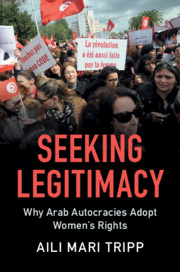Part I - Comparing the Maghreb and the Middle East
Published online by Cambridge University Press: 05 August 2019
Summary
This chapter discusses the divergence and commonalties between the Maghreb (Morocco, Tunisia, and Algeria) and the Middle East when it comes to advancing women’s rights. I hypothesize several possible explanations for the divergence: (1) Maghrebi leaders adopted the political strategy of advancing women’s rights in order to present a modernizing image of their nation to the world and to neutralize Islamist movements, especially extremist ones; (2) the ruling parties, including Islamist parties, sought to stay in power by advancing women’s rights, knowing it would cost them if they did not adopt such reforms; (3) women’s movements exerted pressure resulting in demands for greater accountability (often these reforms occurred in the context of a critical juncture after a change of leadership, the end of a war, a coup d’état, or other major social upheaval); and, finally, (4) the women’s movements in all three countries communicated with each other, thus diffusing goals and strategies. The chapter briefly engages with alternate explanations for women’s rights reforms in the region. One set of explanations relates to cultural factors like kinship and religion, and the other looks at structural factors relating to women’s education, economic growth, the presence of oil rents, and international pressures.
Keywords
- Type
- Chapter
- Information
- Seeking LegitimacyWhy Arab Autocracies Adopt Women's Rights, pp. 29 - 140Publisher: Cambridge University PressPrint publication year: 2019

